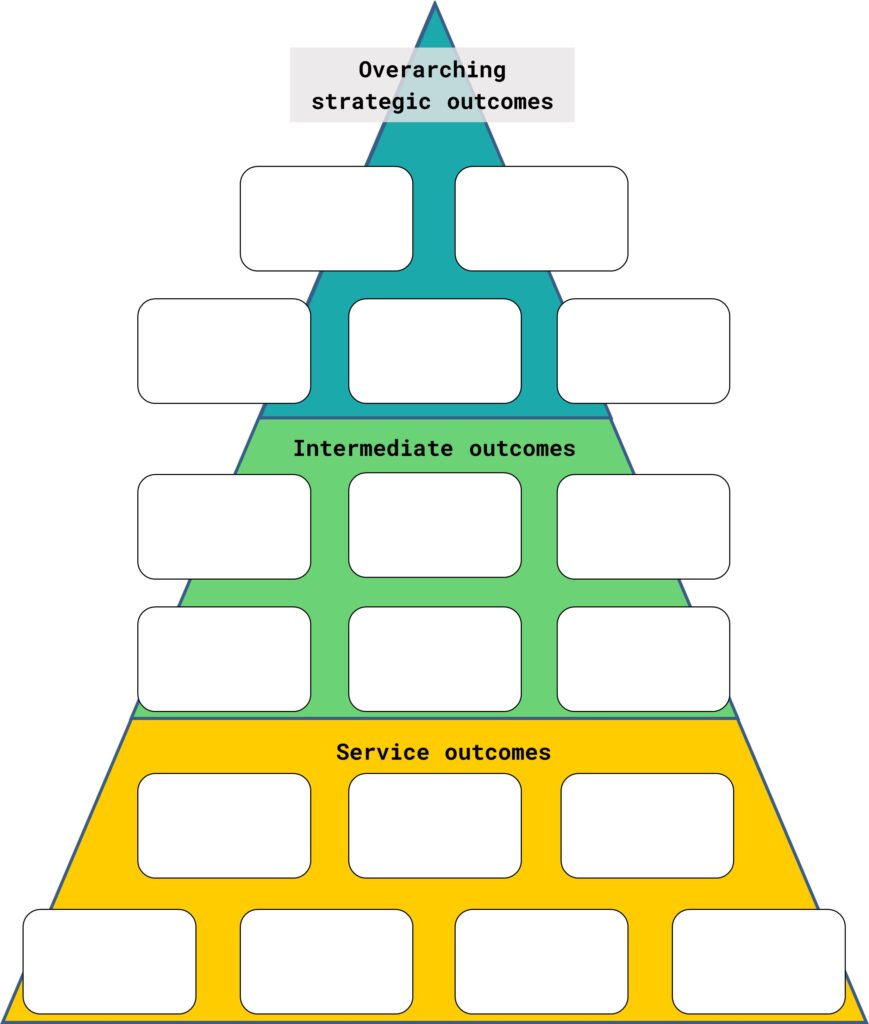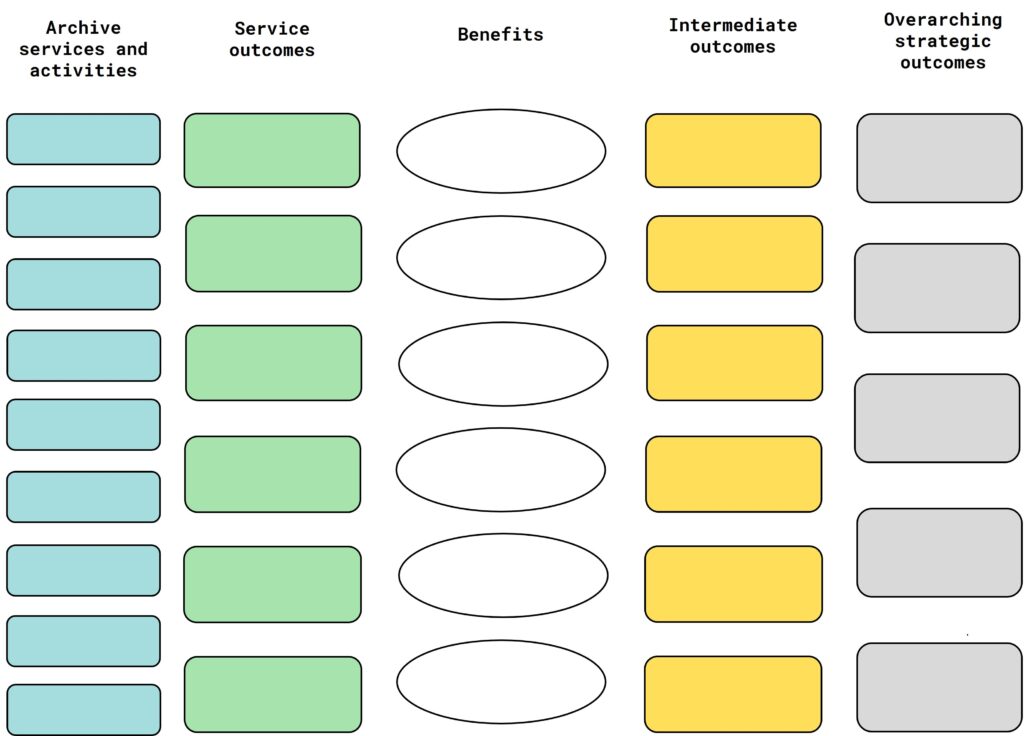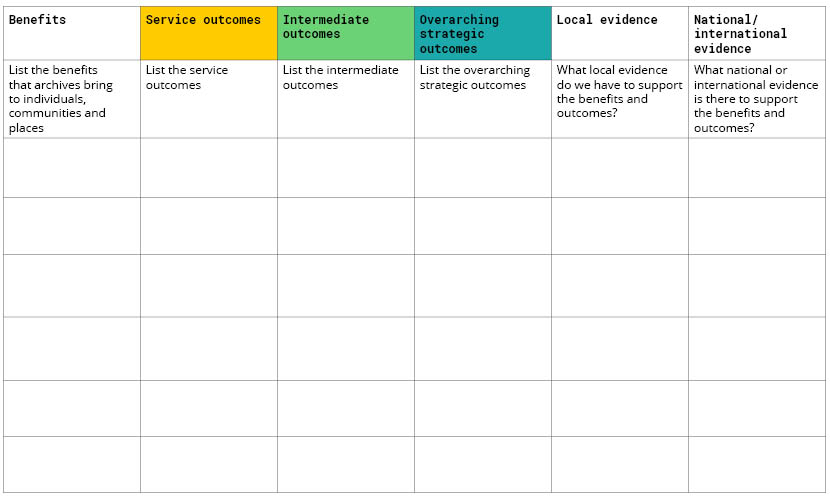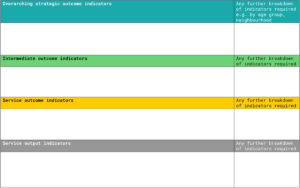Main section
Tabs Navigation
Tabs
Introduction
Archive services need to be able to clearly demonstrate the contribution they make to better outcomes for individuals, communities and places. This is particularly true for local authority archive services, whereby one of the key challenges for public services is demonstrating that investment and action are improving people’s lives.
Demonstrating outcomes will also be useful for any archive that has a low profile amongst key stakeholders, who may not understand the contributions that they can make to a wide range of organisational goals and activities.
Revisions have been made to the original 2014 guidance to ensure the content remains relevant including updated evidence sources, performance indicators and links to other relevant guidance documents.
How will this framework help?
An outcomes framework will help you show clearly the links between the archive services and the achievement of outcomes in your area.
This guide includes example outcomes frameworks that suggest how archive activities may contribute to better outcomes for:
- Health and well-being
- Stronger and safer communities
- Learning and education.
A further example gives suggestions of how archives may contribute to better outcomes across a number of policy themes. The examples are there to give you ideas, not to constrain you. What is important is that you link archive activities to the priorities and outcomes relevant to your own area.
Creating an outcomes framework for archives that does this will help you:
- measure and evidence the difference archives make and the contribution to local priorities
- make the case for continued investment or new investment and develop persuasive funding bids
- communicate the value of archives to opinion formers and decision makers
- align with Archive Accreditation by exploring how your service fits into the wider organisation
- strengthen collaborative working and demonstrate to others why they should be working with archives
- focus business and service plans on the priorities that matter
- promote improvement by identifying what works in delivering better outcomes
- help engage with the commissioning process, this is more relevant if you are in a local authority.
What to include
The sections in this guide will help you create a local outcomes framework for archives consisting of:
- Outcomes triangle
- Logic model
- Evidence
- Performance indicators
Ideally, you should develop all four elements to really show the difference your service makes. But you don’t have to. If you want to start with just an outcomes triangle or logic model you’ll still find that useful.
Outcomes triangle
The outcomes triangle gives an overview of how archives contribute to local priorities, either overall or to a specific policy theme such as health and wellbeing.
It shows the different levels of outcome that archives contribute towards.

Starting from the top, the outcomes triangle shows:
Overarching strategic outcomes
These are very high-level, long-term outcomes that archives, along with other services, contribute to across the local population.
They are likely to reflect the overall responsibilities of key decision-makers; notably local government, but also other key stakeholder groups such as health and social care providers and educational bodies.
Overarching strategic outcomes should resemble the local priorities set out in your local strategic plan, vision statements, partnership agreements, corporate plan, other strategic or partnership documents.
Intermediate outcomes
These are more specific outcomes resulting directly from peoples’ experiences of archives. They are most likely to relate to service users or other specific groups. They show how archives contribute in the short to medium term to the overarching strategic outcomes for the local population.
You may be able to identify intermediate outcomes in your local strategic plan, vision statement, corporate plan, service plans and funding or partnership agreements. If not, you may need to define them based on the differences you understand your service makes to individuals and communities.
Service outcomes
These are outcomes for archive services. Unlike the overarching or intermediate outcomes they are within the direct control of your archive service. Service outcomes should reflect the priorities in your archive service’s strategy, organisation business plan, department or service plans, action plans, partnership or funding agreements.
Follow this step-by-step guide to creating an outcomes triangle and logic model
Download an outcomes triangle template
Logic model
The logic model illustrates the main links between archive activities and local outcomes. It shows understanding of the benefits archives can provide for individuals, communities and places, and how these in turn contribute to the achievement of intermediate and overarching strategic outcomes.

Used from left to right, the logic model will help you evidence, communicate and advocate the contribution of the archive service to the overarching strategic outcomes for your area. This in turn will help you strengthen partnership working and engage with the commissioning process.
Used from right to left, it will encourage service planning, improvement and design that is focused on achieving the overarching strategic outcomes. The underlying assumptions about how and why the activities lead to the different levels of outcome – the ’cause and effect’ relationship between provision and outcomes – should be supported by evidence wherever possible.
Follow this step-by-step guide to creating an outcomes triangle and logic model
Download a logic model template
Evidence list
The evidence section of the framework underpins the outcomes triangle and logic model. It lists the sources of evidence that together best demonstrate the contribution archives make to outcomes.
You should use local evidence such as research studies, evaluations, surveys and case studies to support your outcomes triangle and logic model. You can back this up with evidence from national sources. Some examples of evidence for each of the themes has been provided that may help to underpin your outcomes framework.
Where possible evidence the different levels of outcome and the assumptions linking them together.

Get started with a selection of example evidence lists
Follow this step-by-step guide to reviewing the evidence
Download an evidence list template
Performance indicators
The set of performance indicators (PIs) is how you measure the contribution of archives to local outcomes.

Identify a small number of PIs for each level of outcome (service, intermediate and overarching strategic outcome levels), as well as service output indicators.
Your PIs should provide a mix of outcome-focused quantitative (narrative data – words or communications in text, voice or visual format) and qualitative (numerical data such as counts or numbers) alongside existing management information that will also enable you to demonstrate efficiency and productivity.
Follow this step-by-step guide to selecting performance indicators
Download a performance indicators template
As a starting point, we have provided a series of example outcomes, each using the four frameworks mentioned above.